Financial & Asset Management: Budgeting, Costing, Oman Cement Analysis
VerifiedAdded on 2023/06/14
|12
|3041
|385
Report
AI Summary
This report conducts a financial and asset management analysis, applying accounting and financial management principles to Oman Cement Company. It examines budgetary control techniques such as variance analysis, zero-based budgeting, and responsibility accounting, evaluating their impact on business performance. The report also covers cost-volume-profit analysis, assessing how changes in cost and volume affect operating income. Furthermore, cost control and earned value techniques are applied to evaluate the performance of Oman Cement, focusing on cost reduction and project efficiency within the construction business.
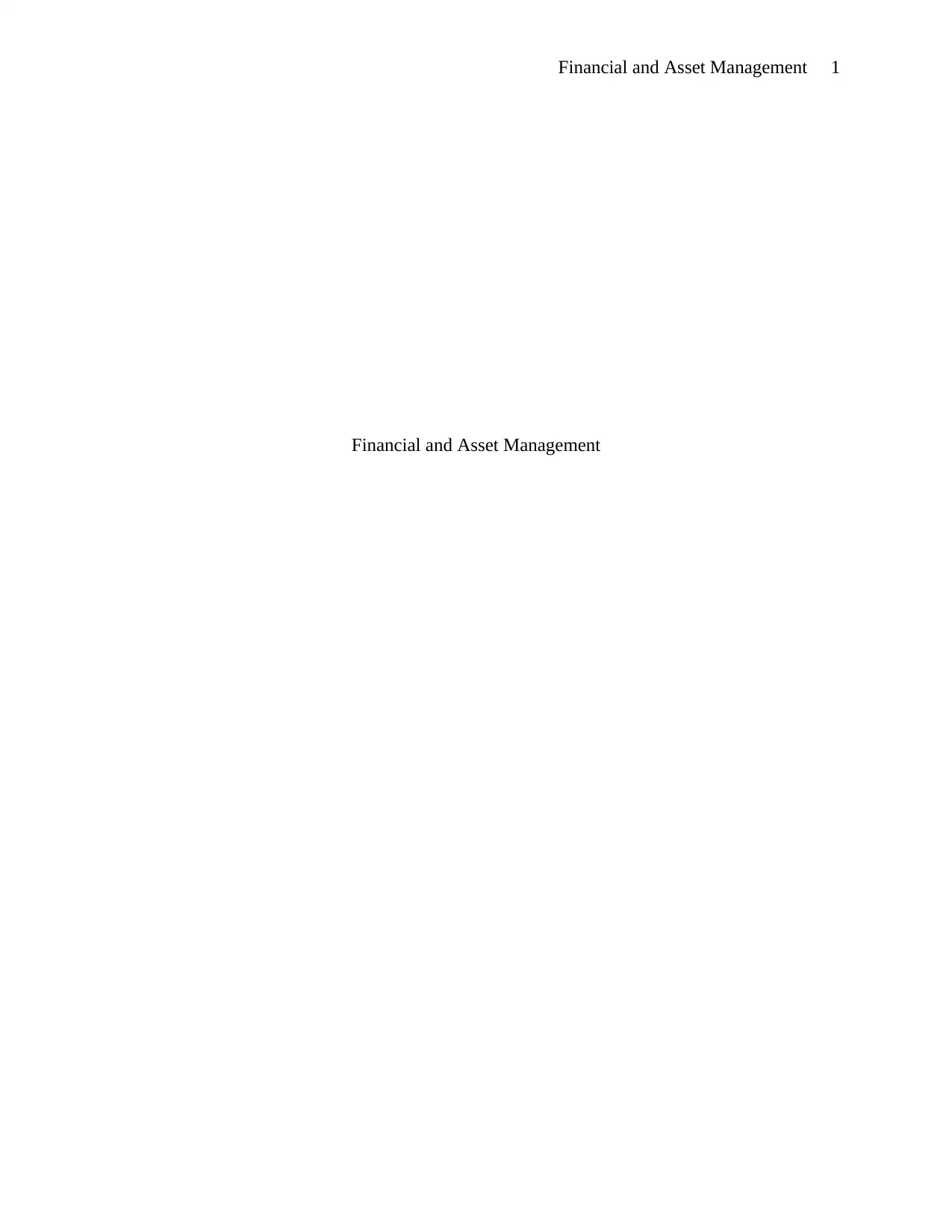
Financial and Asset Management 1
Financial and Asset Management
Financial and Asset Management
Paraphrase This Document
Need a fresh take? Get an instant paraphrase of this document with our AI Paraphraser
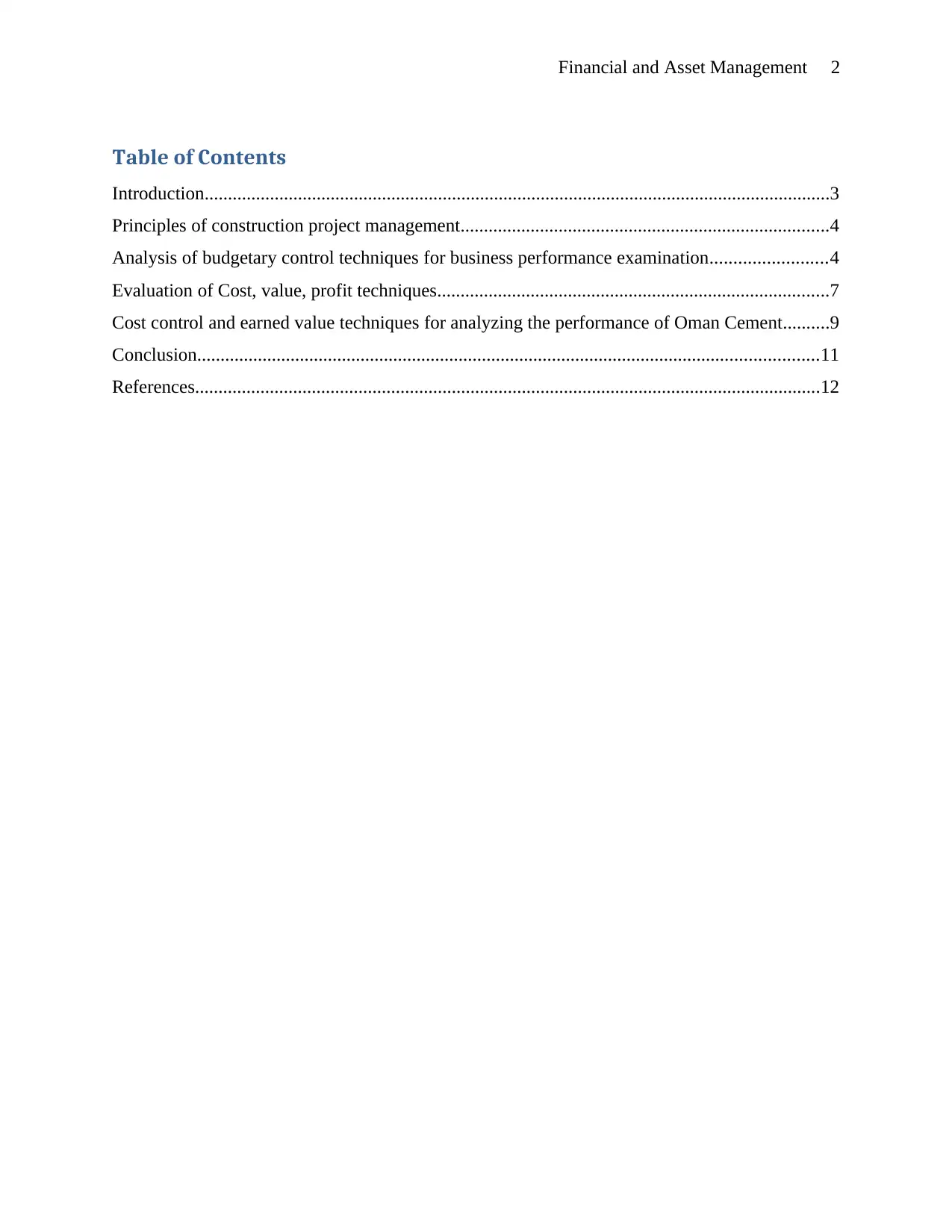
Financial and Asset Management 2
Table of Contents
Introduction......................................................................................................................................3
Principles of construction project management...............................................................................4
Analysis of budgetary control techniques for business performance examination.........................4
Evaluation of Cost, value, profit techniques....................................................................................7
Cost control and earned value techniques for analyzing the performance of Oman Cement..........9
Conclusion.....................................................................................................................................11
References......................................................................................................................................12
Table of Contents
Introduction......................................................................................................................................3
Principles of construction project management...............................................................................4
Analysis of budgetary control techniques for business performance examination.........................4
Evaluation of Cost, value, profit techniques....................................................................................7
Cost control and earned value techniques for analyzing the performance of Oman Cement..........9
Conclusion.....................................................................................................................................11
References......................................................................................................................................12
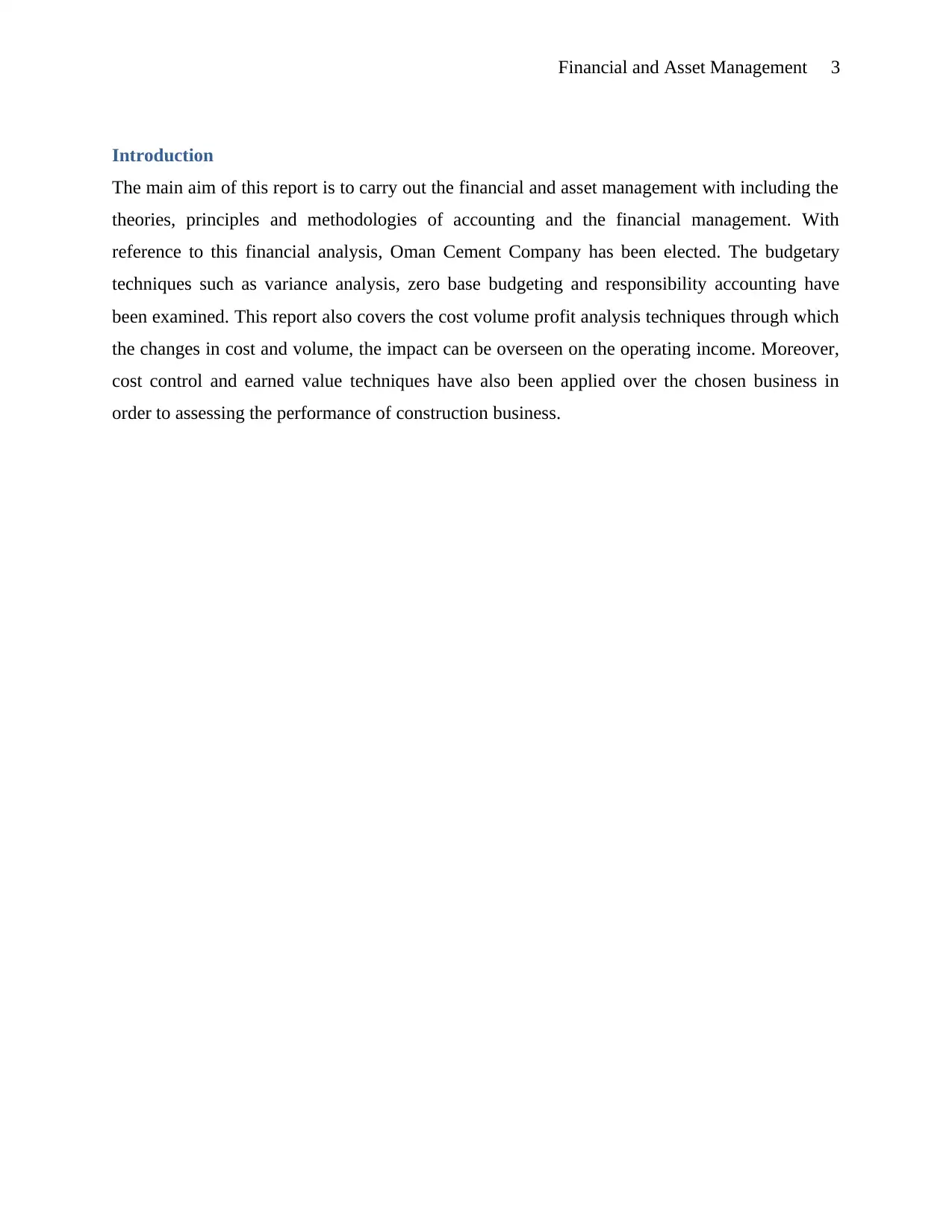
Financial and Asset Management 3
Introduction
The main aim of this report is to carry out the financial and asset management with including the
theories, principles and methodologies of accounting and the financial management. With
reference to this financial analysis, Oman Cement Company has been elected. The budgetary
techniques such as variance analysis, zero base budgeting and responsibility accounting have
been examined. This report also covers the cost volume profit analysis techniques through which
the changes in cost and volume, the impact can be overseen on the operating income. Moreover,
cost control and earned value techniques have also been applied over the chosen business in
order to assessing the performance of construction business.
Introduction
The main aim of this report is to carry out the financial and asset management with including the
theories, principles and methodologies of accounting and the financial management. With
reference to this financial analysis, Oman Cement Company has been elected. The budgetary
techniques such as variance analysis, zero base budgeting and responsibility accounting have
been examined. This report also covers the cost volume profit analysis techniques through which
the changes in cost and volume, the impact can be overseen on the operating income. Moreover,
cost control and earned value techniques have also been applied over the chosen business in
order to assessing the performance of construction business.
⊘ This is a preview!⊘
Do you want full access?
Subscribe today to unlock all pages.

Trusted by 1+ million students worldwide
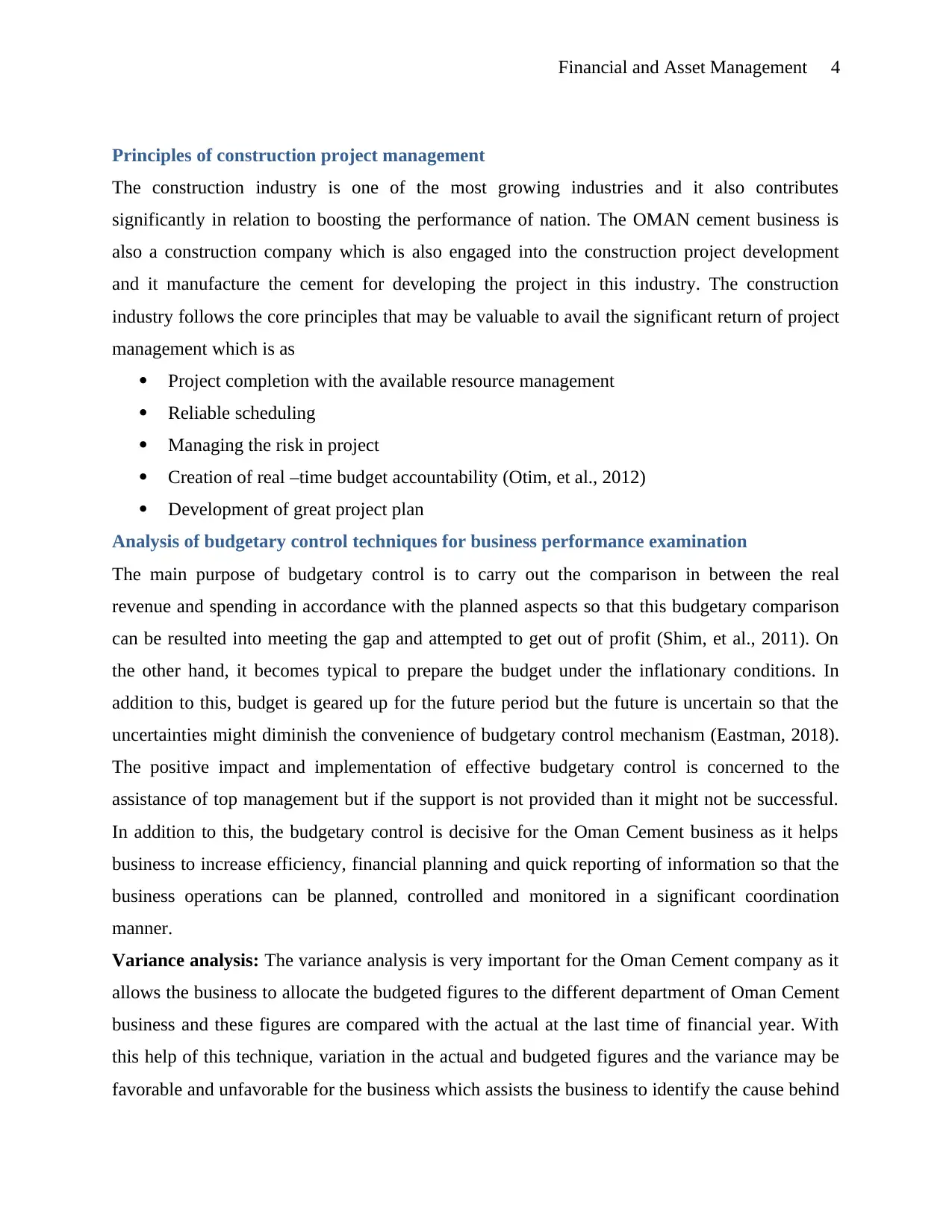
Financial and Asset Management 4
Principles of construction project management
The construction industry is one of the most growing industries and it also contributes
significantly in relation to boosting the performance of nation. The OMAN cement business is
also a construction company which is also engaged into the construction project development
and it manufacture the cement for developing the project in this industry. The construction
industry follows the core principles that may be valuable to avail the significant return of project
management which is as
Project completion with the available resource management
Reliable scheduling
Managing the risk in project
Creation of real –time budget accountability (Otim, et al., 2012)
Development of great project plan
Analysis of budgetary control techniques for business performance examination
The main purpose of budgetary control is to carry out the comparison in between the real
revenue and spending in accordance with the planned aspects so that this budgetary comparison
can be resulted into meeting the gap and attempted to get out of profit (Shim, et al., 2011). On
the other hand, it becomes typical to prepare the budget under the inflationary conditions. In
addition to this, budget is geared up for the future period but the future is uncertain so that the
uncertainties might diminish the convenience of budgetary control mechanism (Eastman, 2018).
The positive impact and implementation of effective budgetary control is concerned to the
assistance of top management but if the support is not provided than it might not be successful.
In addition to this, the budgetary control is decisive for the Oman Cement business as it helps
business to increase efficiency, financial planning and quick reporting of information so that the
business operations can be planned, controlled and monitored in a significant coordination
manner.
Variance analysis: The variance analysis is very important for the Oman Cement company as it
allows the business to allocate the budgeted figures to the different department of Oman Cement
business and these figures are compared with the actual at the last time of financial year. With
this help of this technique, variation in the actual and budgeted figures and the variance may be
favorable and unfavorable for the business which assists the business to identify the cause behind
Principles of construction project management
The construction industry is one of the most growing industries and it also contributes
significantly in relation to boosting the performance of nation. The OMAN cement business is
also a construction company which is also engaged into the construction project development
and it manufacture the cement for developing the project in this industry. The construction
industry follows the core principles that may be valuable to avail the significant return of project
management which is as
Project completion with the available resource management
Reliable scheduling
Managing the risk in project
Creation of real –time budget accountability (Otim, et al., 2012)
Development of great project plan
Analysis of budgetary control techniques for business performance examination
The main purpose of budgetary control is to carry out the comparison in between the real
revenue and spending in accordance with the planned aspects so that this budgetary comparison
can be resulted into meeting the gap and attempted to get out of profit (Shim, et al., 2011). On
the other hand, it becomes typical to prepare the budget under the inflationary conditions. In
addition to this, budget is geared up for the future period but the future is uncertain so that the
uncertainties might diminish the convenience of budgetary control mechanism (Eastman, 2018).
The positive impact and implementation of effective budgetary control is concerned to the
assistance of top management but if the support is not provided than it might not be successful.
In addition to this, the budgetary control is decisive for the Oman Cement business as it helps
business to increase efficiency, financial planning and quick reporting of information so that the
business operations can be planned, controlled and monitored in a significant coordination
manner.
Variance analysis: The variance analysis is very important for the Oman Cement company as it
allows the business to allocate the budgeted figures to the different department of Oman Cement
business and these figures are compared with the actual at the last time of financial year. With
this help of this technique, variation in the actual and budgeted figures and the variance may be
favorable and unfavorable for the business which assists the business to identify the cause behind
Paraphrase This Document
Need a fresh take? Get an instant paraphrase of this document with our AI Paraphraser
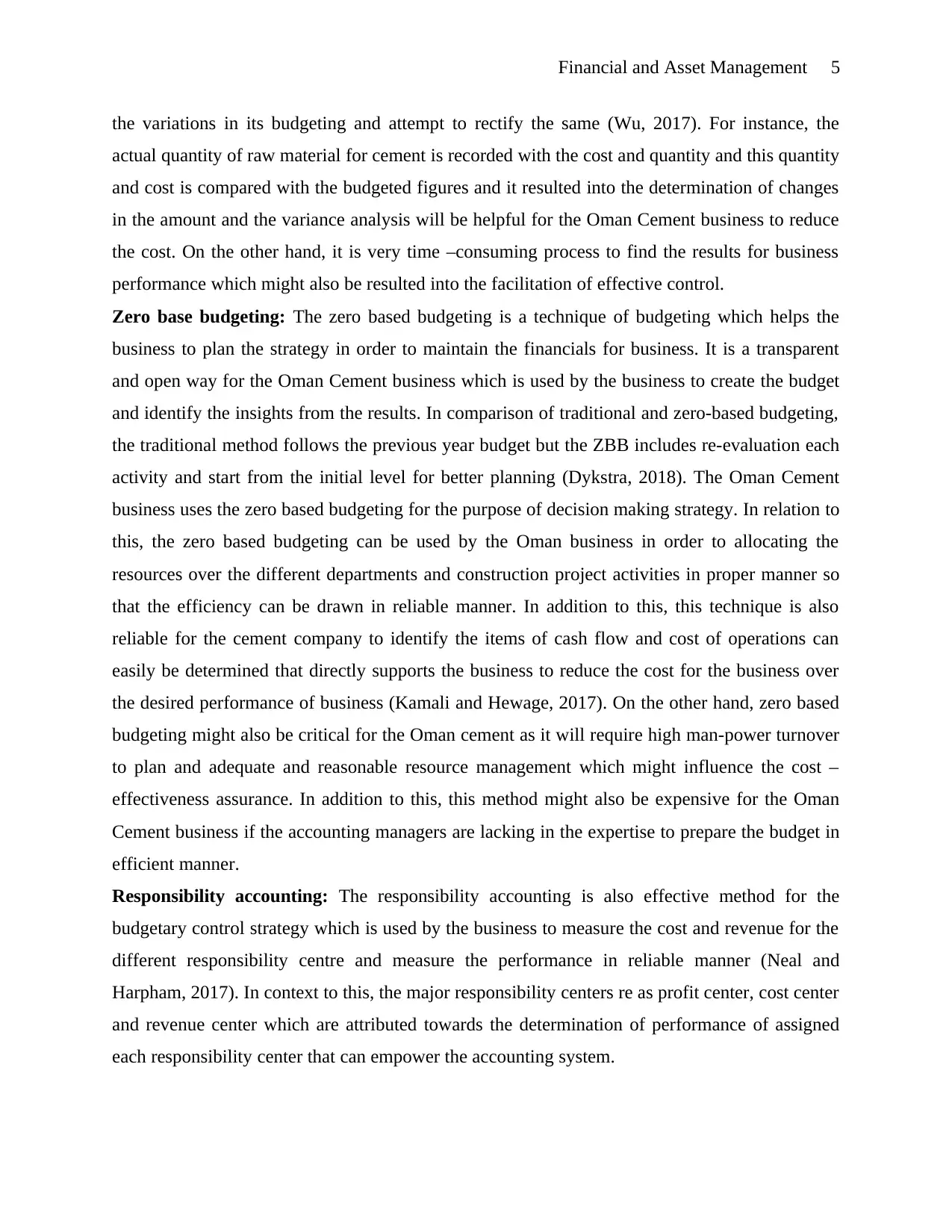
Financial and Asset Management 5
the variations in its budgeting and attempt to rectify the same (Wu, 2017). For instance, the
actual quantity of raw material for cement is recorded with the cost and quantity and this quantity
and cost is compared with the budgeted figures and it resulted into the determination of changes
in the amount and the variance analysis will be helpful for the Oman Cement business to reduce
the cost. On the other hand, it is very time –consuming process to find the results for business
performance which might also be resulted into the facilitation of effective control.
Zero base budgeting: The zero based budgeting is a technique of budgeting which helps the
business to plan the strategy in order to maintain the financials for business. It is a transparent
and open way for the Oman Cement business which is used by the business to create the budget
and identify the insights from the results. In comparison of traditional and zero-based budgeting,
the traditional method follows the previous year budget but the ZBB includes re-evaluation each
activity and start from the initial level for better planning (Dykstra, 2018). The Oman Cement
business uses the zero based budgeting for the purpose of decision making strategy. In relation to
this, the zero based budgeting can be used by the Oman business in order to allocating the
resources over the different departments and construction project activities in proper manner so
that the efficiency can be drawn in reliable manner. In addition to this, this technique is also
reliable for the cement company to identify the items of cash flow and cost of operations can
easily be determined that directly supports the business to reduce the cost for the business over
the desired performance of business (Kamali and Hewage, 2017). On the other hand, zero based
budgeting might also be critical for the Oman cement as it will require high man-power turnover
to plan and adequate and reasonable resource management which might influence the cost –
effectiveness assurance. In addition to this, this method might also be expensive for the Oman
Cement business if the accounting managers are lacking in the expertise to prepare the budget in
efficient manner.
Responsibility accounting: The responsibility accounting is also effective method for the
budgetary control strategy which is used by the business to measure the cost and revenue for the
different responsibility centre and measure the performance in reliable manner (Neal and
Harpham, 2017). In context to this, the major responsibility centers re as profit center, cost center
and revenue center which are attributed towards the determination of performance of assigned
each responsibility center that can empower the accounting system.
the variations in its budgeting and attempt to rectify the same (Wu, 2017). For instance, the
actual quantity of raw material for cement is recorded with the cost and quantity and this quantity
and cost is compared with the budgeted figures and it resulted into the determination of changes
in the amount and the variance analysis will be helpful for the Oman Cement business to reduce
the cost. On the other hand, it is very time –consuming process to find the results for business
performance which might also be resulted into the facilitation of effective control.
Zero base budgeting: The zero based budgeting is a technique of budgeting which helps the
business to plan the strategy in order to maintain the financials for business. It is a transparent
and open way for the Oman Cement business which is used by the business to create the budget
and identify the insights from the results. In comparison of traditional and zero-based budgeting,
the traditional method follows the previous year budget but the ZBB includes re-evaluation each
activity and start from the initial level for better planning (Dykstra, 2018). The Oman Cement
business uses the zero based budgeting for the purpose of decision making strategy. In relation to
this, the zero based budgeting can be used by the Oman business in order to allocating the
resources over the different departments and construction project activities in proper manner so
that the efficiency can be drawn in reliable manner. In addition to this, this technique is also
reliable for the cement company to identify the items of cash flow and cost of operations can
easily be determined that directly supports the business to reduce the cost for the business over
the desired performance of business (Kamali and Hewage, 2017). On the other hand, zero based
budgeting might also be critical for the Oman cement as it will require high man-power turnover
to plan and adequate and reasonable resource management which might influence the cost –
effectiveness assurance. In addition to this, this method might also be expensive for the Oman
Cement business if the accounting managers are lacking in the expertise to prepare the budget in
efficient manner.
Responsibility accounting: The responsibility accounting is also effective method for the
budgetary control strategy which is used by the business to measure the cost and revenue for the
different responsibility centre and measure the performance in reliable manner (Neal and
Harpham, 2017). In context to this, the major responsibility centers re as profit center, cost center
and revenue center which are attributed towards the determination of performance of assigned
each responsibility center that can empower the accounting system.
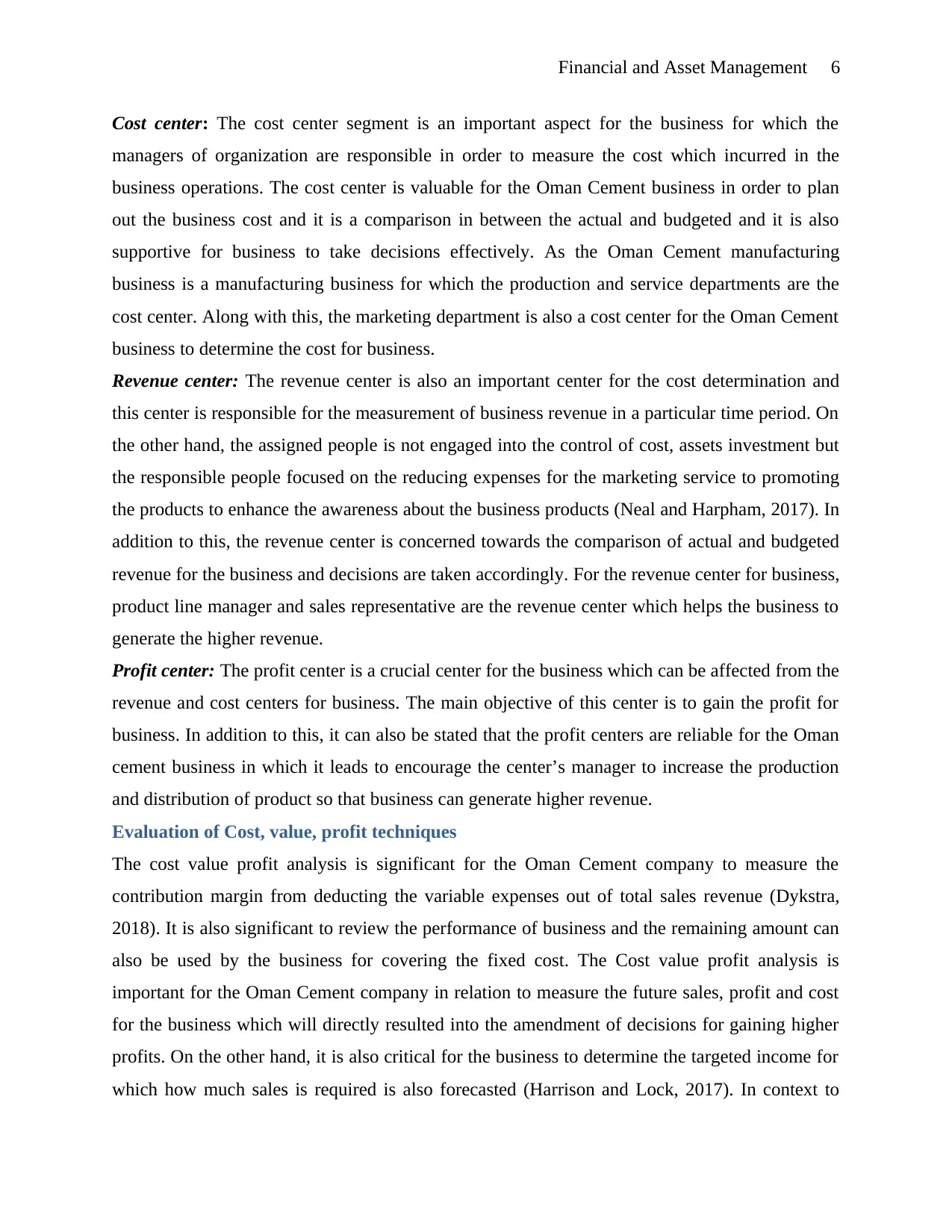
Financial and Asset Management 6
Cost center: The cost center segment is an important aspect for the business for which the
managers of organization are responsible in order to measure the cost which incurred in the
business operations. The cost center is valuable for the Oman Cement business in order to plan
out the business cost and it is a comparison in between the actual and budgeted and it is also
supportive for business to take decisions effectively. As the Oman Cement manufacturing
business is a manufacturing business for which the production and service departments are the
cost center. Along with this, the marketing department is also a cost center for the Oman Cement
business to determine the cost for business.
Revenue center: The revenue center is also an important center for the cost determination and
this center is responsible for the measurement of business revenue in a particular time period. On
the other hand, the assigned people is not engaged into the control of cost, assets investment but
the responsible people focused on the reducing expenses for the marketing service to promoting
the products to enhance the awareness about the business products (Neal and Harpham, 2017). In
addition to this, the revenue center is concerned towards the comparison of actual and budgeted
revenue for the business and decisions are taken accordingly. For the revenue center for business,
product line manager and sales representative are the revenue center which helps the business to
generate the higher revenue.
Profit center: The profit center is a crucial center for the business which can be affected from the
revenue and cost centers for business. The main objective of this center is to gain the profit for
business. In addition to this, it can also be stated that the profit centers are reliable for the Oman
cement business in which it leads to encourage the center’s manager to increase the production
and distribution of product so that business can generate higher revenue.
Evaluation of Cost, value, profit techniques
The cost value profit analysis is significant for the Oman Cement company to measure the
contribution margin from deducting the variable expenses out of total sales revenue (Dykstra,
2018). It is also significant to review the performance of business and the remaining amount can
also be used by the business for covering the fixed cost. The Cost value profit analysis is
important for the Oman Cement company in relation to measure the future sales, profit and cost
for the business which will directly resulted into the amendment of decisions for gaining higher
profits. On the other hand, it is also critical for the business to determine the targeted income for
which how much sales is required is also forecasted (Harrison and Lock, 2017). In context to
Cost center: The cost center segment is an important aspect for the business for which the
managers of organization are responsible in order to measure the cost which incurred in the
business operations. The cost center is valuable for the Oman Cement business in order to plan
out the business cost and it is a comparison in between the actual and budgeted and it is also
supportive for business to take decisions effectively. As the Oman Cement manufacturing
business is a manufacturing business for which the production and service departments are the
cost center. Along with this, the marketing department is also a cost center for the Oman Cement
business to determine the cost for business.
Revenue center: The revenue center is also an important center for the cost determination and
this center is responsible for the measurement of business revenue in a particular time period. On
the other hand, the assigned people is not engaged into the control of cost, assets investment but
the responsible people focused on the reducing expenses for the marketing service to promoting
the products to enhance the awareness about the business products (Neal and Harpham, 2017). In
addition to this, the revenue center is concerned towards the comparison of actual and budgeted
revenue for the business and decisions are taken accordingly. For the revenue center for business,
product line manager and sales representative are the revenue center which helps the business to
generate the higher revenue.
Profit center: The profit center is a crucial center for the business which can be affected from the
revenue and cost centers for business. The main objective of this center is to gain the profit for
business. In addition to this, it can also be stated that the profit centers are reliable for the Oman
cement business in which it leads to encourage the center’s manager to increase the production
and distribution of product so that business can generate higher revenue.
Evaluation of Cost, value, profit techniques
The cost value profit analysis is significant for the Oman Cement company to measure the
contribution margin from deducting the variable expenses out of total sales revenue (Dykstra,
2018). It is also significant to review the performance of business and the remaining amount can
also be used by the business for covering the fixed cost. The Cost value profit analysis is
important for the Oman Cement company in relation to measure the future sales, profit and cost
for the business which will directly resulted into the amendment of decisions for gaining higher
profits. On the other hand, it is also critical for the business to determine the targeted income for
which how much sales is required is also forecasted (Harrison and Lock, 2017). In context to
⊘ This is a preview!⊘
Do you want full access?
Subscribe today to unlock all pages.

Trusted by 1+ million students worldwide
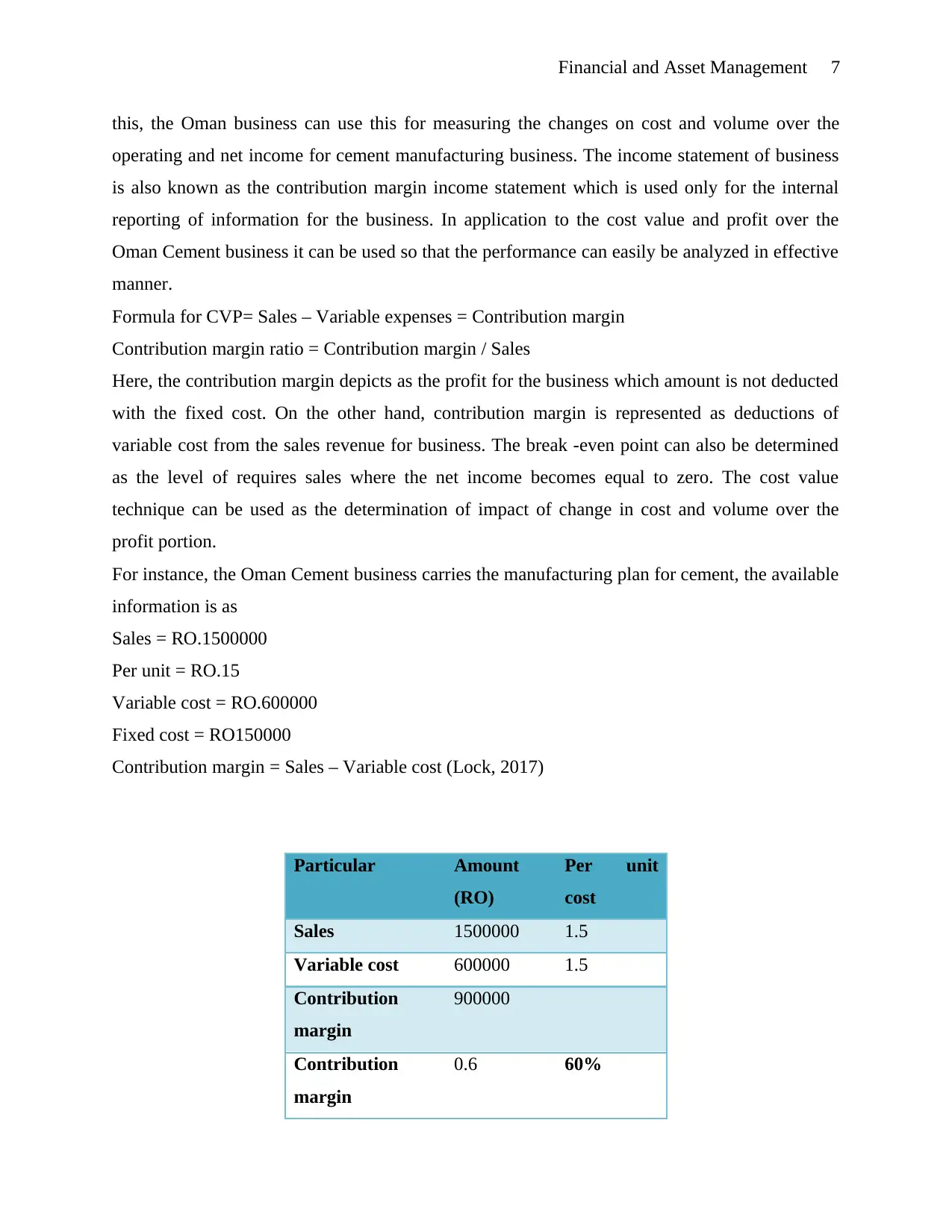
Financial and Asset Management 7
this, the Oman business can use this for measuring the changes on cost and volume over the
operating and net income for cement manufacturing business. The income statement of business
is also known as the contribution margin income statement which is used only for the internal
reporting of information for the business. In application to the cost value and profit over the
Oman Cement business it can be used so that the performance can easily be analyzed in effective
manner.
Formula for CVP= Sales – Variable expenses = Contribution margin
Contribution margin ratio = Contribution margin / Sales
Here, the contribution margin depicts as the profit for the business which amount is not deducted
with the fixed cost. On the other hand, contribution margin is represented as deductions of
variable cost from the sales revenue for business. The break -even point can also be determined
as the level of requires sales where the net income becomes equal to zero. The cost value
technique can be used as the determination of impact of change in cost and volume over the
profit portion.
For instance, the Oman Cement business carries the manufacturing plan for cement, the available
information is as
Sales = RO.1500000
Per unit = RO.15
Variable cost = RO.600000
Fixed cost = RO150000
Contribution margin = Sales – Variable cost (Lock, 2017)
Particular Amount
(RO)
Per unit
cost
Sales 1500000 1.5
Variable cost 600000 1.5
Contribution
margin
900000
Contribution
margin
0.6 60%
this, the Oman business can use this for measuring the changes on cost and volume over the
operating and net income for cement manufacturing business. The income statement of business
is also known as the contribution margin income statement which is used only for the internal
reporting of information for the business. In application to the cost value and profit over the
Oman Cement business it can be used so that the performance can easily be analyzed in effective
manner.
Formula for CVP= Sales – Variable expenses = Contribution margin
Contribution margin ratio = Contribution margin / Sales
Here, the contribution margin depicts as the profit for the business which amount is not deducted
with the fixed cost. On the other hand, contribution margin is represented as deductions of
variable cost from the sales revenue for business. The break -even point can also be determined
as the level of requires sales where the net income becomes equal to zero. The cost value
technique can be used as the determination of impact of change in cost and volume over the
profit portion.
For instance, the Oman Cement business carries the manufacturing plan for cement, the available
information is as
Sales = RO.1500000
Per unit = RO.15
Variable cost = RO.600000
Fixed cost = RO150000
Contribution margin = Sales – Variable cost (Lock, 2017)
Particular Amount
(RO)
Per unit
cost
Sales 1500000 1.5
Variable cost 600000 1.5
Contribution
margin
900000
Contribution
margin
0.6 60%
Paraphrase This Document
Need a fresh take? Get an instant paraphrase of this document with our AI Paraphraser
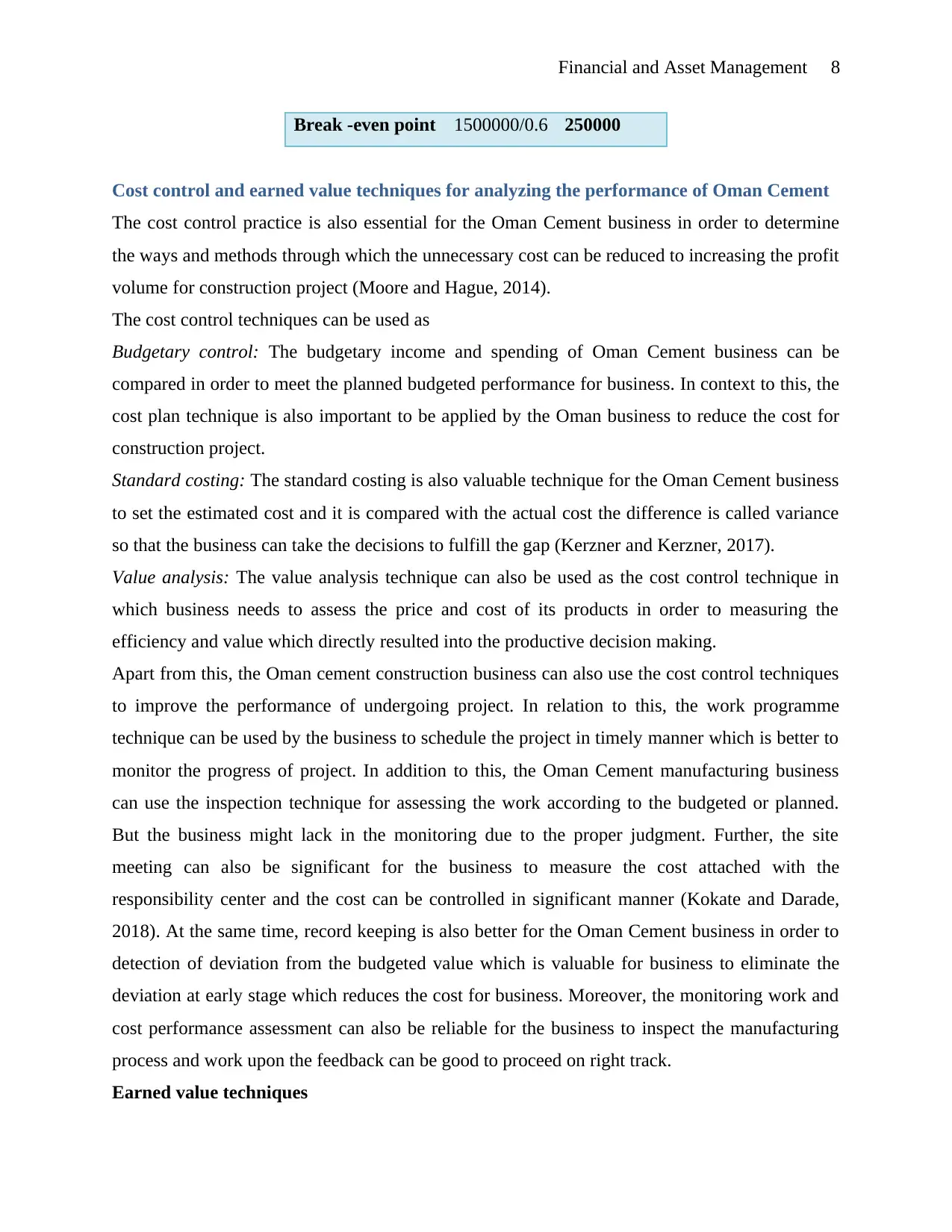
Financial and Asset Management 8
Break -even point 1500000/0.6 250000
Cost control and earned value techniques for analyzing the performance of Oman Cement
The cost control practice is also essential for the Oman Cement business in order to determine
the ways and methods through which the unnecessary cost can be reduced to increasing the profit
volume for construction project (Moore and Hague, 2014).
The cost control techniques can be used as
Budgetary control: The budgetary income and spending of Oman Cement business can be
compared in order to meet the planned budgeted performance for business. In context to this, the
cost plan technique is also important to be applied by the Oman business to reduce the cost for
construction project.
Standard costing: The standard costing is also valuable technique for the Oman Cement business
to set the estimated cost and it is compared with the actual cost the difference is called variance
so that the business can take the decisions to fulfill the gap (Kerzner and Kerzner, 2017).
Value analysis: The value analysis technique can also be used as the cost control technique in
which business needs to assess the price and cost of its products in order to measuring the
efficiency and value which directly resulted into the productive decision making.
Apart from this, the Oman cement construction business can also use the cost control techniques
to improve the performance of undergoing project. In relation to this, the work programme
technique can be used by the business to schedule the project in timely manner which is better to
monitor the progress of project. In addition to this, the Oman Cement manufacturing business
can use the inspection technique for assessing the work according to the budgeted or planned.
But the business might lack in the monitoring due to the proper judgment. Further, the site
meeting can also be significant for the business to measure the cost attached with the
responsibility center and the cost can be controlled in significant manner (Kokate and Darade,
2018). At the same time, record keeping is also better for the Oman Cement business in order to
detection of deviation from the budgeted value which is valuable for business to eliminate the
deviation at early stage which reduces the cost for business. Moreover, the monitoring work and
cost performance assessment can also be reliable for the business to inspect the manufacturing
process and work upon the feedback can be good to proceed on right track.
Earned value techniques
Break -even point 1500000/0.6 250000
Cost control and earned value techniques for analyzing the performance of Oman Cement
The cost control practice is also essential for the Oman Cement business in order to determine
the ways and methods through which the unnecessary cost can be reduced to increasing the profit
volume for construction project (Moore and Hague, 2014).
The cost control techniques can be used as
Budgetary control: The budgetary income and spending of Oman Cement business can be
compared in order to meet the planned budgeted performance for business. In context to this, the
cost plan technique is also important to be applied by the Oman business to reduce the cost for
construction project.
Standard costing: The standard costing is also valuable technique for the Oman Cement business
to set the estimated cost and it is compared with the actual cost the difference is called variance
so that the business can take the decisions to fulfill the gap (Kerzner and Kerzner, 2017).
Value analysis: The value analysis technique can also be used as the cost control technique in
which business needs to assess the price and cost of its products in order to measuring the
efficiency and value which directly resulted into the productive decision making.
Apart from this, the Oman cement construction business can also use the cost control techniques
to improve the performance of undergoing project. In relation to this, the work programme
technique can be used by the business to schedule the project in timely manner which is better to
monitor the progress of project. In addition to this, the Oman Cement manufacturing business
can use the inspection technique for assessing the work according to the budgeted or planned.
But the business might lack in the monitoring due to the proper judgment. Further, the site
meeting can also be significant for the business to measure the cost attached with the
responsibility center and the cost can be controlled in significant manner (Kokate and Darade,
2018). At the same time, record keeping is also better for the Oman Cement business in order to
detection of deviation from the budgeted value which is valuable for business to eliminate the
deviation at early stage which reduces the cost for business. Moreover, the monitoring work and
cost performance assessment can also be reliable for the business to inspect the manufacturing
process and work upon the feedback can be good to proceed on right track.
Earned value techniques
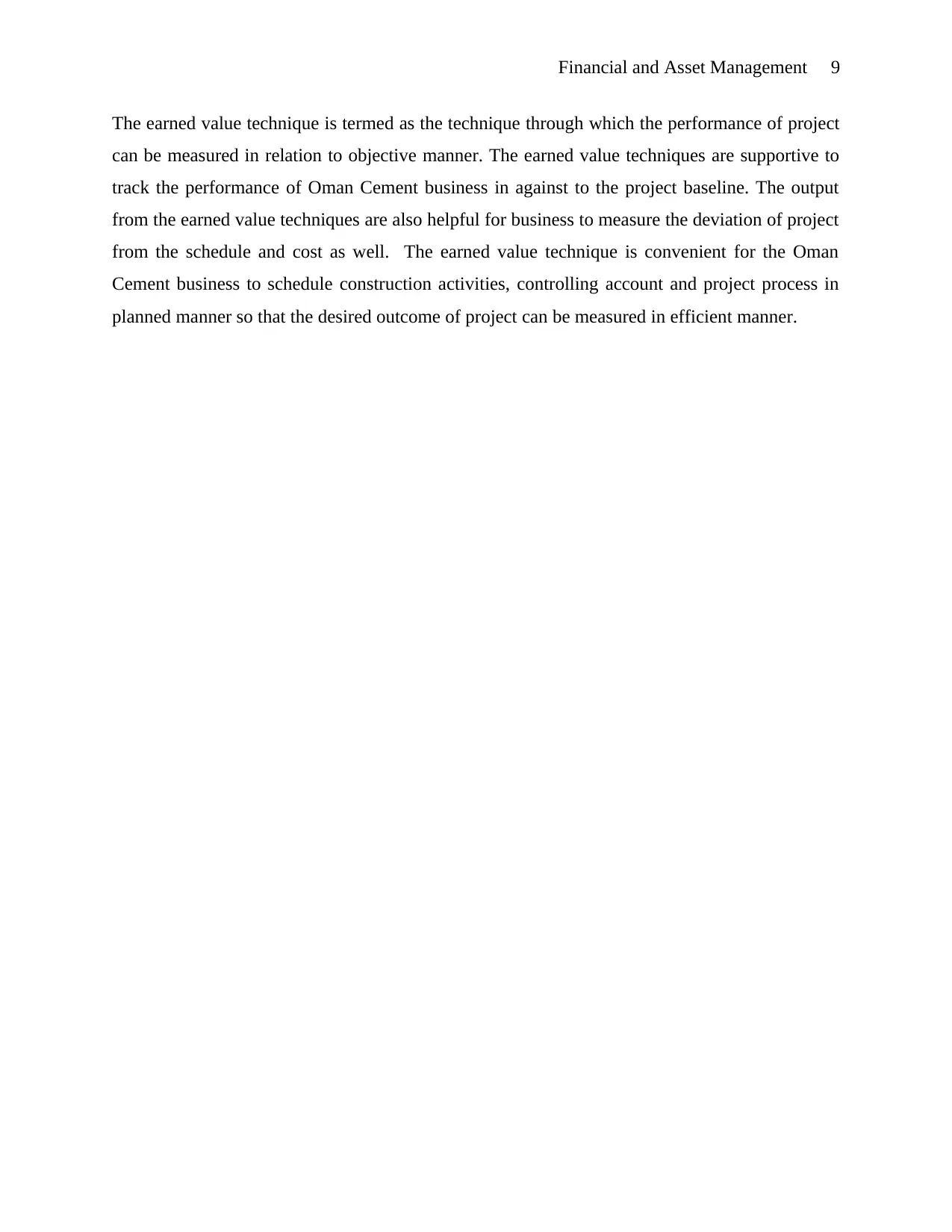
Financial and Asset Management 9
The earned value technique is termed as the technique through which the performance of project
can be measured in relation to objective manner. The earned value techniques are supportive to
track the performance of Oman Cement business in against to the project baseline. The output
from the earned value techniques are also helpful for business to measure the deviation of project
from the schedule and cost as well. The earned value technique is convenient for the Oman
Cement business to schedule construction activities, controlling account and project process in
planned manner so that the desired outcome of project can be measured in efficient manner.
The earned value technique is termed as the technique through which the performance of project
can be measured in relation to objective manner. The earned value techniques are supportive to
track the performance of Oman Cement business in against to the project baseline. The output
from the earned value techniques are also helpful for business to measure the deviation of project
from the schedule and cost as well. The earned value technique is convenient for the Oman
Cement business to schedule construction activities, controlling account and project process in
planned manner so that the desired outcome of project can be measured in efficient manner.
⊘ This is a preview!⊘
Do you want full access?
Subscribe today to unlock all pages.

Trusted by 1+ million students worldwide
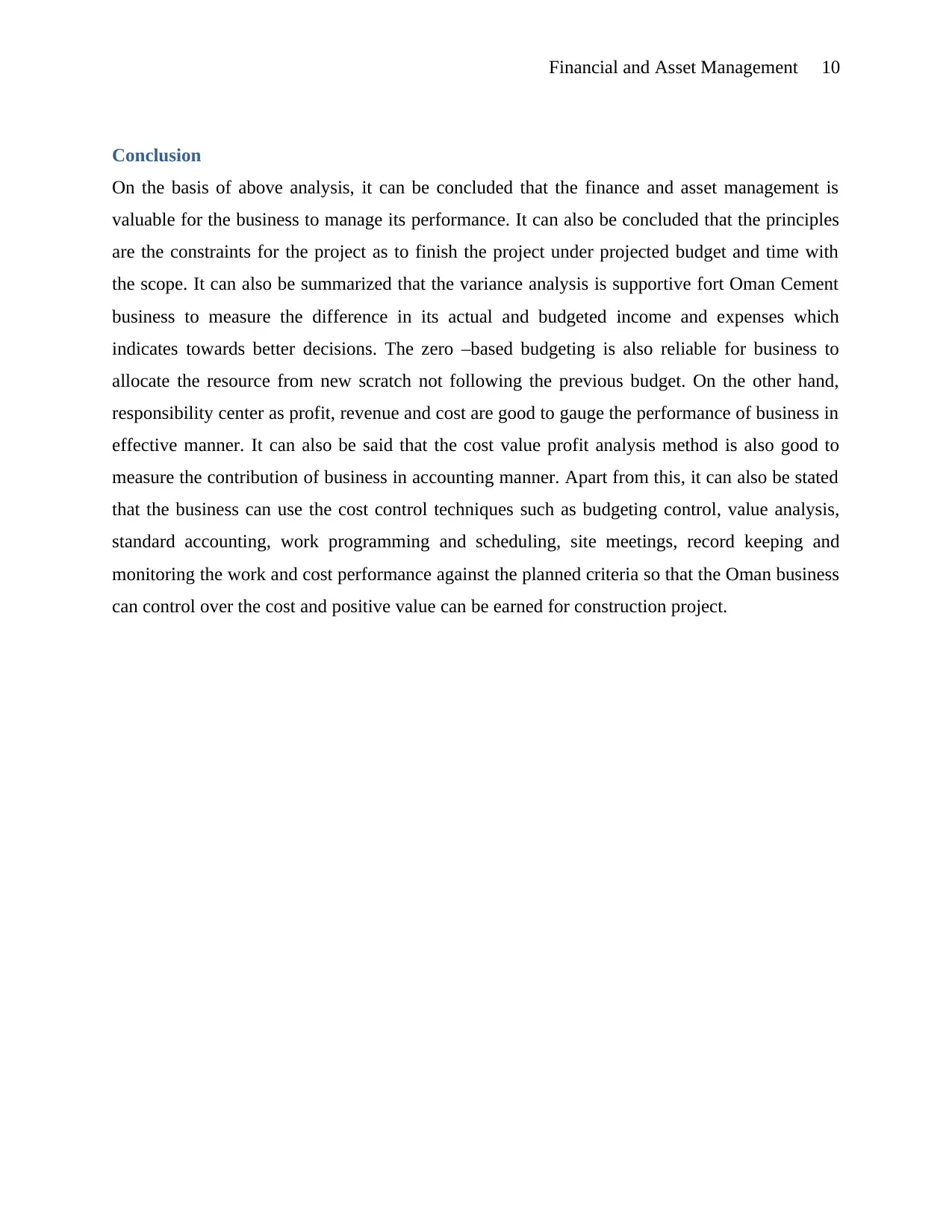
Financial and Asset Management 10
Conclusion
On the basis of above analysis, it can be concluded that the finance and asset management is
valuable for the business to manage its performance. It can also be concluded that the principles
are the constraints for the project as to finish the project under projected budget and time with
the scope. It can also be summarized that the variance analysis is supportive fort Oman Cement
business to measure the difference in its actual and budgeted income and expenses which
indicates towards better decisions. The zero –based budgeting is also reliable for business to
allocate the resource from new scratch not following the previous budget. On the other hand,
responsibility center as profit, revenue and cost are good to gauge the performance of business in
effective manner. It can also be said that the cost value profit analysis method is also good to
measure the contribution of business in accounting manner. Apart from this, it can also be stated
that the business can use the cost control techniques such as budgeting control, value analysis,
standard accounting, work programming and scheduling, site meetings, record keeping and
monitoring the work and cost performance against the planned criteria so that the Oman business
can control over the cost and positive value can be earned for construction project.
Conclusion
On the basis of above analysis, it can be concluded that the finance and asset management is
valuable for the business to manage its performance. It can also be concluded that the principles
are the constraints for the project as to finish the project under projected budget and time with
the scope. It can also be summarized that the variance analysis is supportive fort Oman Cement
business to measure the difference in its actual and budgeted income and expenses which
indicates towards better decisions. The zero –based budgeting is also reliable for business to
allocate the resource from new scratch not following the previous budget. On the other hand,
responsibility center as profit, revenue and cost are good to gauge the performance of business in
effective manner. It can also be said that the cost value profit analysis method is also good to
measure the contribution of business in accounting manner. Apart from this, it can also be stated
that the business can use the cost control techniques such as budgeting control, value analysis,
standard accounting, work programming and scheduling, site meetings, record keeping and
monitoring the work and cost performance against the planned criteria so that the Oman business
can control over the cost and positive value can be earned for construction project.
Paraphrase This Document
Need a fresh take? Get an instant paraphrase of this document with our AI Paraphraser
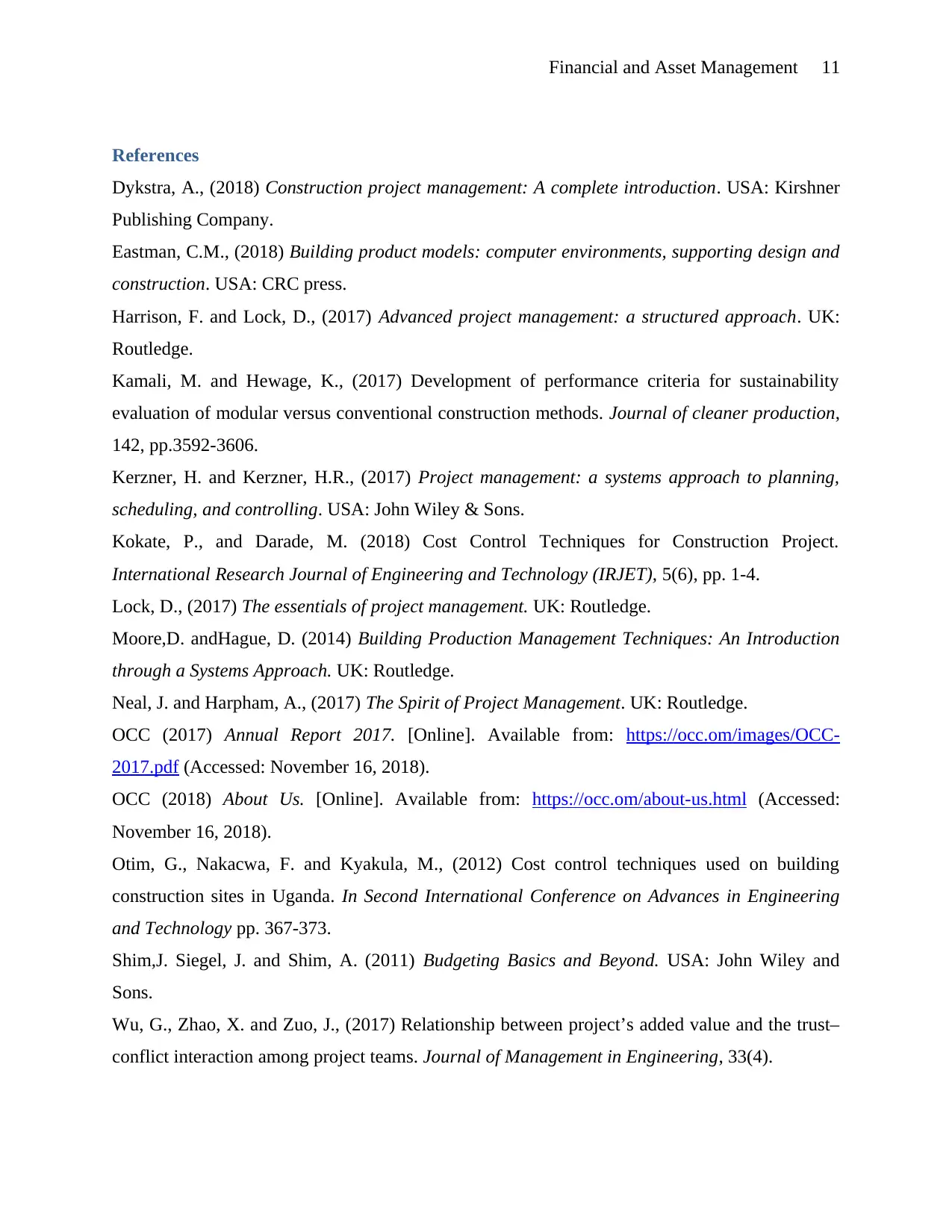
Financial and Asset Management 11
References
Dykstra, A., (2018) Construction project management: A complete introduction. USA: Kirshner
Publishing Company.
Eastman, C.M., (2018) Building product models: computer environments, supporting design and
construction. USA: CRC press.
Harrison, F. and Lock, D., (2017) Advanced project management: a structured approach. UK:
Routledge.
Kamali, M. and Hewage, K., (2017) Development of performance criteria for sustainability
evaluation of modular versus conventional construction methods. Journal of cleaner production,
142, pp.3592-3606.
Kerzner, H. and Kerzner, H.R., (2017) Project management: a systems approach to planning,
scheduling, and controlling. USA: John Wiley & Sons.
Kokate, P., and Darade, M. (2018) Cost Control Techniques for Construction Project.
International Research Journal of Engineering and Technology (IRJET), 5(6), pp. 1-4.
Lock, D., (2017) The essentials of project management. UK: Routledge.
Moore,D. andHague, D. (2014) Building Production Management Techniques: An Introduction
through a Systems Approach. UK: Routledge.
Neal, J. and Harpham, A., (2017) The Spirit of Project Management. UK: Routledge.
OCC (2017) Annual Report 2017. [Online]. Available from: https://occ.om/images/OCC-
2017.pdf (Accessed: November 16, 2018).
OCC (2018) About Us. [Online]. Available from: https://occ.om/about-us.html (Accessed:
November 16, 2018).
Otim, G., Nakacwa, F. and Kyakula, M., (2012) Cost control techniques used on building
construction sites in Uganda. In Second International Conference on Advances in Engineering
and Technology pp. 367-373.
Shim,J. Siegel, J. and Shim, A. (2011) Budgeting Basics and Beyond. USA: John Wiley and
Sons.
Wu, G., Zhao, X. and Zuo, J., (2017) Relationship between project’s added value and the trust–
conflict interaction among project teams. Journal of Management in Engineering, 33(4).
References
Dykstra, A., (2018) Construction project management: A complete introduction. USA: Kirshner
Publishing Company.
Eastman, C.M., (2018) Building product models: computer environments, supporting design and
construction. USA: CRC press.
Harrison, F. and Lock, D., (2017) Advanced project management: a structured approach. UK:
Routledge.
Kamali, M. and Hewage, K., (2017) Development of performance criteria for sustainability
evaluation of modular versus conventional construction methods. Journal of cleaner production,
142, pp.3592-3606.
Kerzner, H. and Kerzner, H.R., (2017) Project management: a systems approach to planning,
scheduling, and controlling. USA: John Wiley & Sons.
Kokate, P., and Darade, M. (2018) Cost Control Techniques for Construction Project.
International Research Journal of Engineering and Technology (IRJET), 5(6), pp. 1-4.
Lock, D., (2017) The essentials of project management. UK: Routledge.
Moore,D. andHague, D. (2014) Building Production Management Techniques: An Introduction
through a Systems Approach. UK: Routledge.
Neal, J. and Harpham, A., (2017) The Spirit of Project Management. UK: Routledge.
OCC (2017) Annual Report 2017. [Online]. Available from: https://occ.om/images/OCC-
2017.pdf (Accessed: November 16, 2018).
OCC (2018) About Us. [Online]. Available from: https://occ.om/about-us.html (Accessed:
November 16, 2018).
Otim, G., Nakacwa, F. and Kyakula, M., (2012) Cost control techniques used on building
construction sites in Uganda. In Second International Conference on Advances in Engineering
and Technology pp. 367-373.
Shim,J. Siegel, J. and Shim, A. (2011) Budgeting Basics and Beyond. USA: John Wiley and
Sons.
Wu, G., Zhao, X. and Zuo, J., (2017) Relationship between project’s added value and the trust–
conflict interaction among project teams. Journal of Management in Engineering, 33(4).

Financial and Asset Management 12
⊘ This is a preview!⊘
Do you want full access?
Subscribe today to unlock all pages.

Trusted by 1+ million students worldwide
1 out of 12
Related Documents
Your All-in-One AI-Powered Toolkit for Academic Success.
+13062052269
info@desklib.com
Available 24*7 on WhatsApp / Email
![[object Object]](/_next/static/media/star-bottom.7253800d.svg)
Unlock your academic potential
Copyright © 2020–2025 A2Z Services. All Rights Reserved. Developed and managed by ZUCOL.





